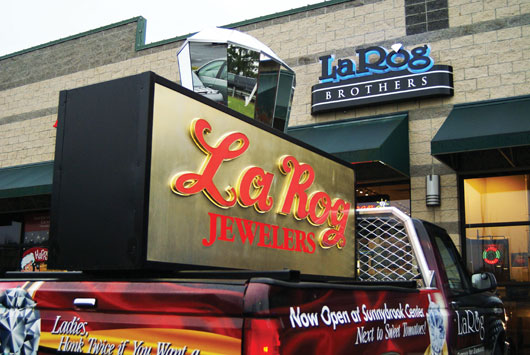
[dropcap cap=D]ave and Rick Rogoway, owners of LaRog Brothers Jewelers, grew up in the family’s store in Portland, OR, which was known for the revolving sign on its roof. They learned the business there, following the example of their dad, Stan Rogoway, who began working in that store at age 8. Dave and Rick opened a second store in 1981, but they held on to the original location. When they learned it was to be razed to make way for a mini-mall, they looked forward to the next phase of their business. A new location would mean more room for relaxed diamond viewing and custom design work. But they also began looking back with nostalgia. “My great-grandfather opened the first store in Portand in 1896,” Dave Rogoway says. Their nostalgia extended to the big sign, which they thought would wind up in a sign graveyard, if they couldn’t come up with a better idea. — Eileen McClelland[/dropcap]
[componentheading]THE IDEA[/componentheading]
[contentheading]Rolling advertising[/contentheading]

Create a distinctive, portable billboard that reflects the company history as well as its specialty: diamond bridal jewelry.
Advertisement
A landmark, 15-foot revolving neon diamond was mounted on the top of LaRog Brothers Jewelers on a busy corner of Portland, OR, since the ’60s. When the store was forced to relocate, Dave and Rick Rogoway knew they could not install the revolving sign in a new location because of city codes. As they braced for demolition, the Oregonian newspaper published a story about the impending demise of the retro-cool sign. “Everyone was asking what would become of the famous neon sign on the landmark diamond corner,” Dave says. So, using their website blog, they asked customers for suggestions. But the idea they embraced came from closer to home. “My son, Tyler, a nightclub owner, had a great idea. We would take the sign off the building and mount it on a cool truck, which would become a moving billboard.”
[componentheading]THE EXECUTION[/componentheading]
[contentheading]Major undertaking[/contentheading]
The sign was rewired and the truck was shrink-wrapped with signs.
“We had to take it off with cranes from the roof of the building,” Dave says. “It was a large undertaking, having it professionally mounted into the truck.” A generator provides illumination at night. They introduced the truck with a radio promotion. “The station gave out hints about the secret destination of the diamond truck, and the first 10 people to find it got Journey Diamond jewelry,” Dave says. “There were so many people driving around looking for it that we were lucky we didn’t have accidents.
[componentheading]THE REWARD[/componentheading]
Advertisement
[contentheading]Visibility with minimal cost[/contentheading]
The Rogoways have figured out a way to gain great visibility at minimal cost. A good billboard in a good Portland location would cost about $8,000 a month. The traveling sign costs far less and is more versatile. The initial outlay was $5,900 for the truck and $1,200 for the shrink-wrap signage. The Rogoways employ a driver for $11 an hour and gas amounts to about $80 a week. “It can be used so many ways, in parades and for promotions. We have driven it around as a moving billboard. We park it in the lot of the shopping center on a knoll so it is seen from the major freeway,” Dave says, “I think it’s a clever way of taking a historic sign and being able to save it and make it work for you.”
[componentheading]TRY IT YOURSELF[/componentheading]
Consider which piece of your building or brand could most easily go on the road for maximum visibility.
“Use your imagination or draw on the imagination of others,” Dave says. “I would have never come up with this idea. My son brought it up, we thought about it, and said, ‘It’s a good idea.’ ”
Alert the media. Once you have a mobile advertisement, tie it in to find-the-truck promotions with rewards valuable enough to attract plenty of publicity.
Advertisement
[span class=note]This story is from the June 2008 edition of INSTORE[/span]